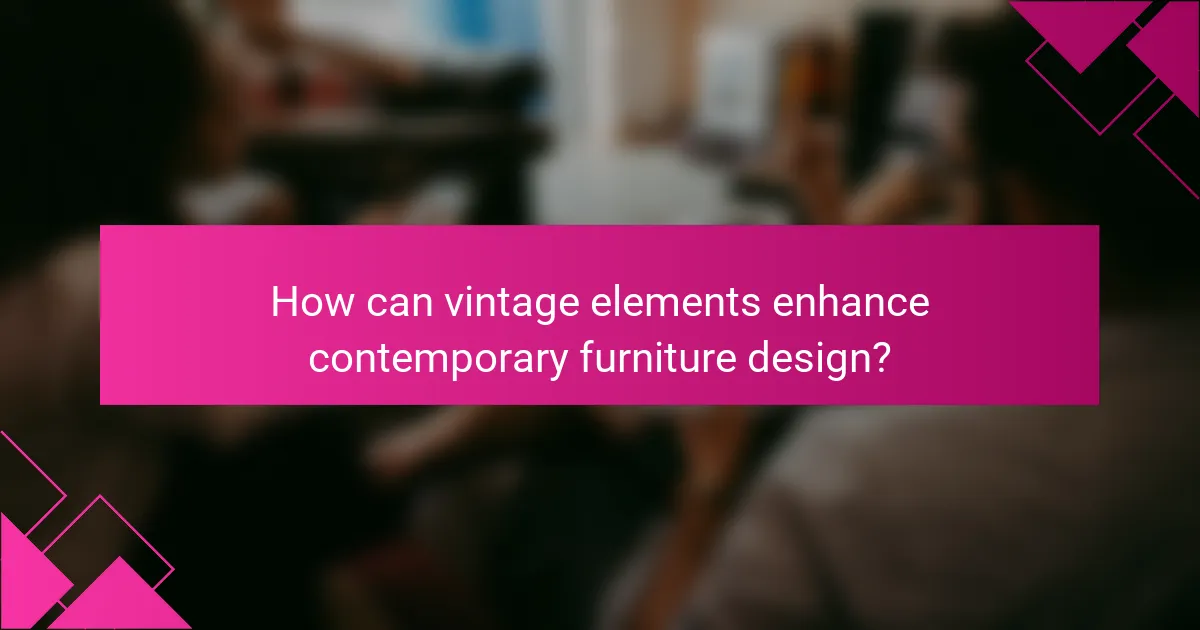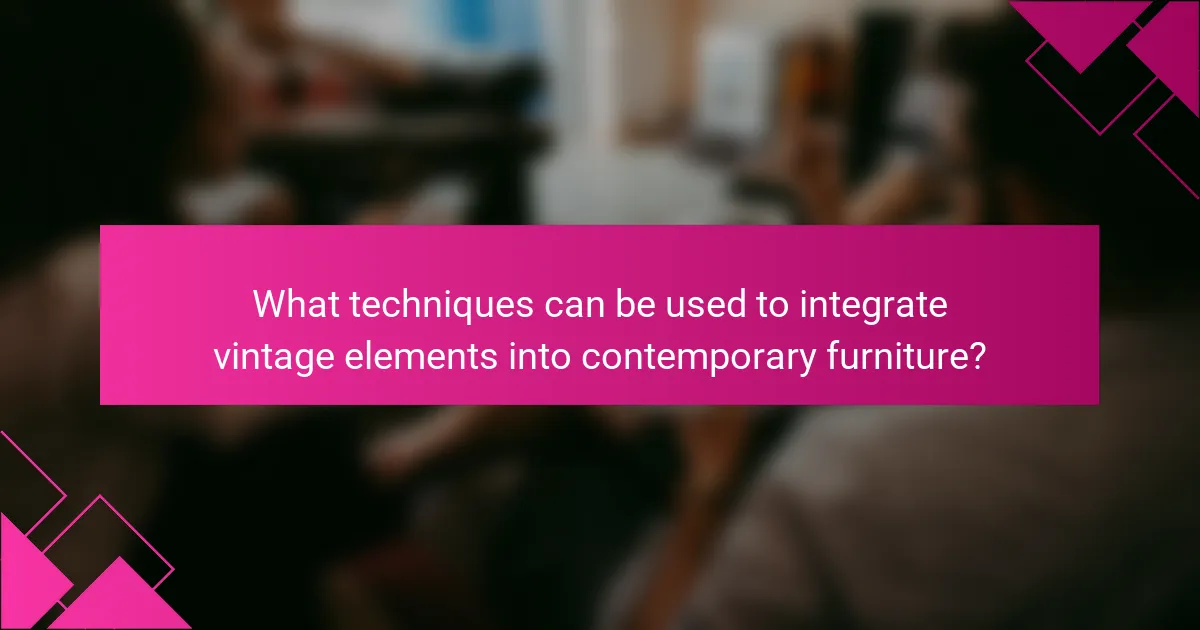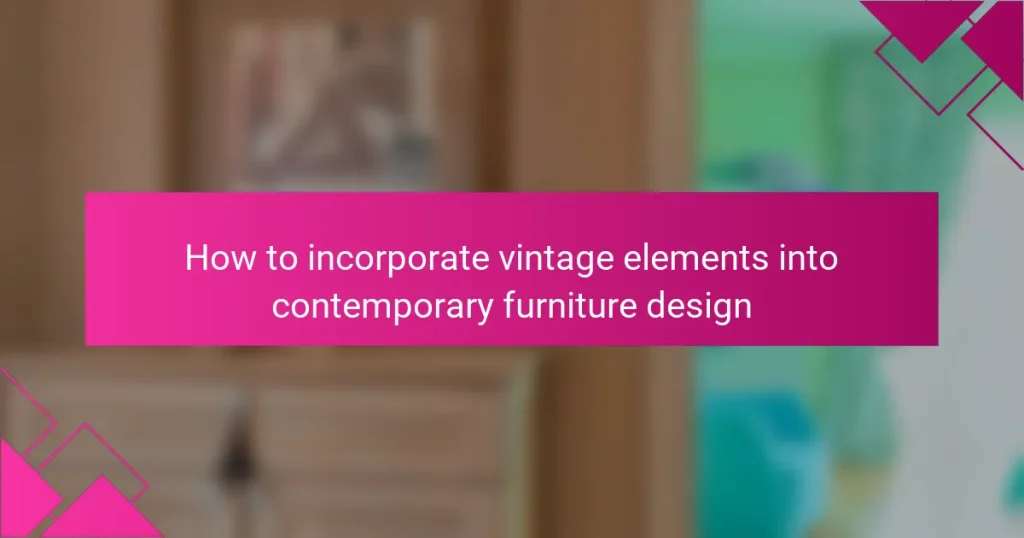Incorporating vintage elements into contemporary furniture design enhances character and uniqueness while providing historical context and nostalgia. Techniques for blending these styles include using vintage materials like reclaimed wood, integrating vintage patterns, and combining accessories such as antique lamps with modern pieces. Effective strategies also involve layering different styles, employing vintage-inspired hardware, and maintaining a cohesive color palette. By balancing vintage and contemporary items, designers can create inviting spaces that showcase the charm of both styles while ensuring functionality.

How can vintage elements enhance contemporary furniture design?
Vintage elements can enhance contemporary furniture design by adding character and uniqueness. They introduce historical context and nostalgia into modern settings. This blend creates a richer aesthetic experience. For example, mid-century modern pieces can complement minimalist designs effectively. The contrast between old and new can evoke visual interest. Vintage materials, such as reclaimed wood, offer sustainability benefits. They also provide tactile warmth that cold, modern materials lack. Incorporating vintage elements can lead to a more personalized and inviting space.
What are the key characteristics of vintage design elements?
Vintage design elements are characterized by their nostalgic aesthetic and unique craftsmanship. They often feature ornate details, such as intricate patterns and textures. Common materials include wood, metal, and glass, reflecting durability and quality. Color palettes tend to be muted or pastel, evoking a sense of warmth and comfort. Vintage designs frequently incorporate retro shapes and silhouettes, which add visual interest. The use of reclaimed or distressed finishes is also prevalent, enhancing the authenticity of the piece. These elements are often inspired by specific historical periods, such as Art Deco or Mid-Century Modern. Overall, vintage design elements create a timeless appeal that blends seamlessly with contemporary styles.
How do materials used in vintage furniture differ from contemporary ones?
Vintage furniture typically uses natural materials like solid wood, metal, and leather. Contemporary furniture often incorporates synthetic materials such as engineered wood, plastics, and composites. Vintage pieces are known for their craftsmanship and durability, often using techniques like dovetail joints. In contrast, contemporary designs may prioritize cost-effectiveness and mass production. Vintage furniture often features unique, high-quality finishes that age beautifully over time. Contemporary furniture may have more uniform finishes that prioritize ease of maintenance. Historical context shows that vintage furniture was often made to last for generations, while contemporary furniture may focus more on trends and aesthetics.
What design styles are considered vintage?
Vintage design styles include Art Deco, Mid-Century Modern, and Shabby Chic. Art Deco emerged in the 1920s and features geometric shapes and bold colors. Mid-Century Modern became popular in the 1950s, emphasizing clean lines and organic forms. Shabby Chic, originating in the 1980s, showcases a worn, vintage look with pastel colors and floral patterns. These styles reflect historical trends and aesthetics, making them recognizable and sought after in contemporary design.
Why should designers incorporate vintage elements into their work?
Designers should incorporate vintage elements into their work to enhance aesthetic appeal and evoke nostalgia. Vintage elements often provide a unique character that contemporary designs may lack. They can create a sense of authenticity, making pieces feel more personal and relatable. Incorporating vintage styles can also connect modern designs to historical contexts, enriching the narrative of the product. Research shows that consumers are increasingly drawn to products that reflect craftsmanship and history. A study by the National Endowment for the Arts found that 62% of Americans appreciate art that connects to the past. This trend indicates a market preference for designs that blend the old with the new. Therefore, using vintage elements can lead to greater consumer engagement and satisfaction.
What aesthetic benefits do vintage elements provide?
Vintage elements enhance aesthetic appeal by introducing character and uniqueness to contemporary designs. They create a sense of nostalgia that resonates with many individuals. Incorporating vintage pieces can add depth and texture to a space. This blend of old and new fosters visual interest and contrasts. Vintage elements often feature craftsmanship that is less common in modern mass-produced items. They can serve as conversation starters, drawing attention and admiration. Furthermore, vintage styles can complement various design themes, from rustic to industrial. Research shows that spaces with vintage decor can evoke positive emotions and a sense of comfort.
How can vintage elements contribute to sustainability in furniture design?
Vintage elements contribute to sustainability in furniture design by promoting reuse and reducing waste. Incorporating vintage pieces minimizes the demand for new materials. This practice lessens the environmental impact associated with manufacturing processes. Additionally, vintage furniture often boasts durability, leading to longer product lifespans. Studies show that reusing furniture can significantly lower carbon footprints. For example, a report by the Ellen MacArthur Foundation highlights that extending the life of furniture can reduce emissions by up to 70%. Utilizing vintage elements also preserves cultural heritage and craftsmanship. This approach encourages a circular economy by keeping resources in use longer. Overall, vintage elements provide a sustainable alternative to fast furniture trends.

What techniques can be used to integrate vintage elements into contemporary furniture?
Mixing vintage elements with contemporary furniture can be achieved through various techniques. One effective method is to use vintage materials, such as reclaimed wood or antique fabrics, in new designs. This practice not only adds character but also promotes sustainability. Another technique involves incorporating vintage patterns or colors into contemporary pieces. For instance, using retro upholstery on modern chairs can create a striking contrast.
Combining vintage accessories, like antique lamps or artwork, with contemporary furniture also enhances the overall aesthetic. This approach creates visual interest and a sense of history. Additionally, furniture can be designed with vintage silhouettes while using modern construction methods. This allows for the nostalgic feel of vintage design with the durability of contemporary craftsmanship.
Layering different styles is another technique; mixing mid-century modern pieces with industrial elements can create a unique hybrid look. Finally, employing vintage-inspired hardware, such as knobs or pulls, on contemporary furniture can seamlessly blend the two styles. These techniques collectively enrich contemporary furniture with vintage charm while maintaining functionality.
How can color palettes blend vintage and contemporary styles?
Color palettes can blend vintage and contemporary styles by combining muted, earthy tones with vibrant, modern hues. Vintage styles often utilize colors like mustard yellow, olive green, and dusty rose. These colors evoke nostalgia and warmth. Contemporary styles favor bold and bright colors such as teal, coral, and electric blue.
To achieve a harmonious blend, designers can use a neutral base, like beige or gray, to anchor the palette. This allows vintage colors to stand out without overwhelming the contemporary elements. Additionally, incorporating patterns that feature both vintage and modern colors can create a cohesive look.
For instance, a vintage floral pattern can be paired with a modern geometric design. This juxtaposition highlights the uniqueness of both styles. Balancing the saturation levels of colors also helps maintain visual harmony. Using a mix of matte and glossy finishes can further enhance the blend of styles.
What color combinations work best for this integration?
Complementary color combinations work best for integrating vintage elements into contemporary furniture design. Pairing rich, warm hues like burgundy with cool tones such as teal creates a balanced aesthetic. Earthy tones like olive green combined with soft pastels can evoke a nostalgic feel while remaining modern. Neutral colors like beige or gray can anchor vintage pieces within a contemporary palette. Using gold or brass accents alongside deep jewel tones enhances the vintage appeal. This approach creates a cohesive atmosphere that honors both styles effectively.
How do vintage colors influence the overall design?
Vintage colors significantly influence overall design by evoking nostalgia and creating a unique atmosphere. These colors often include muted tones, pastels, and earthy shades. They can enhance the aesthetic appeal of contemporary furniture by adding warmth and character. Vintage colors help to establish a cohesive theme that resonates with historical contexts. For example, a soft mint green or faded mustard yellow can transport the viewer to a different era. This use of color can also affect emotional responses, making spaces feel more inviting. Additionally, vintage colors can complement modern materials, bridging the gap between old and new styles. Overall, incorporating vintage colors enriches the design narrative and attracts attention.
What furniture pieces are ideal for incorporating vintage elements?
Ideal furniture pieces for incorporating vintage elements include armchairs, sideboards, and coffee tables. Armchairs with mid-century designs often feature unique upholstery and shapes. Sideboards from the 1950s or 1960s provide ample storage and character. Coffee tables made from reclaimed wood or featuring retro designs add charm. Vintage lighting fixtures, such as chandeliers or table lamps, enhance the overall aesthetic. Additionally, antique dressers or cabinets serve as statement pieces. These items help blend modern and vintage styles effectively.
Which types of contemporary furniture benefit most from vintage accents?
Contemporary furniture types that benefit most from vintage accents include sofas, dining tables, and accent chairs. Sofas with vintage throw pillows or fabrics can create a warm, inviting atmosphere. Dining tables paired with vintage tableware enhance the dining experience. Accent chairs in vintage styles add character to modern spaces. These combinations create a unique blend of old and new, appealing to diverse design preferences. Vintage accents often introduce textures and colors that contemporary pieces might lack. This integration fosters a more personalized and eclectic interior design.
How can vintage accessories enhance contemporary furniture?
Vintage accessories can enhance contemporary furniture by adding character and uniqueness. They introduce a sense of history and nostalgia that modern design often lacks. For instance, a vintage lamp can serve as a striking focal point in a minimalist room. Combining old and new creates visual contrast, making the space more dynamic. Vintage items often feature craftsmanship and materials not commonly found in contemporary pieces. This can elevate the overall aesthetic and quality of the interior. Additionally, using vintage accessories can promote sustainability by encouraging the reuse of existing items. Studies show that mixing styles can lead to a more personalized and inviting atmosphere in home design.

What are some practical tips for successfully merging vintage and contemporary designs?
To successfully merge vintage and contemporary designs, start with a cohesive color palette. Choose colors that complement both styles. Incorporate statement vintage pieces as focal points. This creates a visual anchor in the space. Mix textures by pairing sleek contemporary materials with rich vintage fabrics. This adds depth and interest to the design. Use modern furniture layouts to highlight vintage accessories. This approach ensures functionality while showcasing the vintage elements. Balance the space by distributing vintage and contemporary items evenly. This prevents one style from overpowering the other. Finally, consider scale and proportion when selecting pieces. Well-proportioned items will harmonize the different styles effectively.
How can one maintain balance between vintage and contemporary elements?
To maintain balance between vintage and contemporary elements, one should strategically blend both styles. This can be achieved by selecting a few key vintage pieces to serve as focal points. For instance, a vintage armchair can complement a modern sofa. Color schemes play a vital role; using a cohesive palette can unify different styles. Mixing textures is also effective; pairing sleek contemporary materials with warm vintage fabrics adds depth. Scale is important; ensure that the size of vintage items works harmoniously with contemporary furniture. Accessorizing with modern art can bridge the gap between the two styles. Finally, personal taste should guide the selection process, ensuring that the space feels authentic and comfortable.
What common mistakes should be avoided when mixing styles?
Common mistakes to avoid when mixing styles include lack of cohesion and over-cluttering spaces. Cohesion is essential for a harmonious look. Mixing too many styles can create visual chaos. Another mistake is ignoring scale and proportion. Furniture should complement each other in size. Using clashing colors or patterns can disrupt the aesthetic balance. It is important to maintain a consistent color palette. Additionally, neglecting the context of the space can lead to mismatched elements. Each piece should feel purposeful within the overall design. Lastly, failing to incorporate personal touches can make the design feel impersonal. Personal elements help to create a unique and inviting atmosphere.
How can one create a cohesive look with vintage and contemporary furniture?
To create a cohesive look with vintage and contemporary furniture, select a common color palette. This palette should connect both styles visually. Incorporate materials that bridge the gap, such as wood or metal. Balance the scale of furniture pieces to ensure harmony in the space. Use accessories that complement both styles, like art or textiles. Arrange furniture to create a flow that feels intentional. Mix patterns thoughtfully to avoid visual chaos. Finally, ensure that lighting ties the elements together, enhancing the overall aesthetic.
What resources are available for sourcing vintage elements?
Antique shops, flea markets, and online marketplaces are key resources for sourcing vintage elements. Antique shops often have curated collections of vintage items. Flea markets provide a variety of unique finds from different eras. Online marketplaces like eBay and Etsy offer a wide range of vintage goods. Estate sales can also be a valuable source, often featuring items from specific time periods. Auctions may feature rare vintage pieces that are hard to find elsewhere. Local thrift stores can yield unexpected vintage treasures at low prices. Networking with vintage enthusiasts can lead to private sales and recommendations for sourcing.
Where can designers find authentic vintage pieces?
Designers can find authentic vintage pieces at antique shops, flea markets, and estate sales. These venues often carry unique items with historical significance. Online platforms like Etsy and eBay also offer a wide range of vintage finds. Additionally, specialized vintage stores curate collections from various eras. Auctions can be a great source for rare pieces as well. Social media marketplaces allow local sellers to connect with buyers seeking vintage items. Each of these sources provides opportunities to discover authentic vintage furniture and accessories.
How can online platforms assist in sourcing vintage furniture?
Online platforms can assist in sourcing vintage furniture by providing access to a wide range of listings. Websites and apps dedicated to vintage items connect buyers with sellers globally. These platforms often feature user reviews, ensuring credibility and quality. Many offer filtering options to narrow searches by style, era, or price. Additionally, social media marketplaces facilitate direct communication with sellers. Online auctions can provide opportunities to bid on unique pieces. Some platforms also curate collections, simplifying the search process. Overall, these digital resources enhance the accessibility and variety of vintage furniture options.
What are the best practices for showcasing vintage elements in contemporary spaces?
To showcase vintage elements in contemporary spaces, integrate them thoughtfully with modern design. Balance is crucial; avoid overwhelming the contemporary aesthetic. Use vintage pieces as focal points to draw attention. Pair vintage items with neutral palettes to enhance their uniqueness. Ensure that vintage elements complement the functionality of the space. Consider scale and proportion to maintain harmony between old and new. Incorporate vintage textures and materials to add depth and interest. Finally, curate a cohesive narrative that connects the vintage elements with the overall design theme.
The main entity of the article is the incorporation of vintage elements into contemporary furniture design. The article explores how vintage elements enhance modern aesthetics by adding character, historical context, and sustainability. Key characteristics of vintage design, including materials, styles, and color palettes, are examined, alongside practical techniques for merging vintage and contemporary styles. The article also addresses the benefits of vintage accessories, sourcing authentic pieces, and best practices for showcasing vintage elements effectively in modern spaces. Overall, it provides a comprehensive guide for designers and homeowners interested in blending vintage charm with contemporary functionality.


